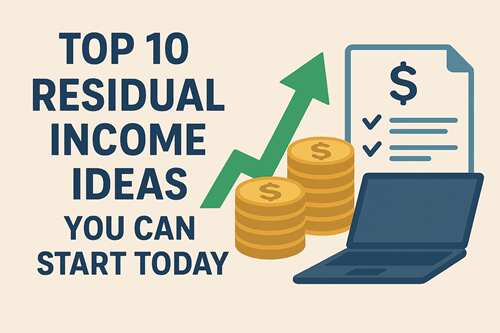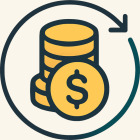TOP 10 Residual Income Ideas You Can Start Today
Quick definition up front: residual income means money that keeps flowing to you after the initial work or investment is done. Think royalties from a song, monthly dividends from a stock, or rent checks that arrive while you sleep. Some people call this passive residual income; others use the term in accounting to mean profit after a required return. Both views are useful, and I’ll show you how to think about each as you pick an idea to start.

Why this article, and what you’ll actually get
You want real, actionable options: ideas you can start now, a feel for startup cost and time, plus simple next steps so you don't get stuck in analysis paralysis. I’ll also show the residual income formula used in business accounting and a short, clear example so you can calculate whether an idea makes sense for you.
Residual income: simple meanings (so we are aligned)
- Everyday/creator meaning: recurring money that arrives after you create a product or set up a system (e.g., course sales, subscriptions, royalties).
- Accounting meaning: the profit left after the company earns its required return on invested capital. The formula you’ll see in business books is:
Residual Income (RI) = Net Operating Income - (Required Rate of Return x Operating Assets)Example, step by step arithmetic:
Net Operating Income = 50,000
Operating Assets = 300,000
Required Rate of Return = 8% = 0.08
Calculate required return: 0.08 x 300,000 = 24,000
Compute RI: 50,000 - 24,000 = 26,000
So the residual income here is 26,000 for the period. Use that when evaluating business investments and ROI like comparisons.
TOP 10 Residual Income Ideas You Can Start Today
Below I give each idea: what it's, why it generates residual income, rough startup cost/time, what to watch for, and one immediate step you can take today.
1) Create and sell an online course
Why: a course is recorded once, sold many times. Add updates and funnels, and you get recurring enrollments.
Startup cost / time: low to medium; camera/mic and course platform fees; 2-8 weeks to launch a first mini course.
Watch for: content quality, pricing, marketing. Courses can stagnate without updates.
Start today: outline 3 core lessons, record one sample video, upload to a simple platform.
2) Self publish an ebook or guides
Why: royalties keep coming; a book feeds email lists and affiliate funnels.
Startup cost / time: very low cost; a few days to a few weeks depending on length.
Watch for: discoverability; cover and blurb matter.
Start today: write a 1,500 word guide solving a narrow problem and publish it as a low priced ebook.
3) Dividend investing
Why: owning dividend paying stocks or ETFs pays cash regularly, compounding if reinvested.
Startup cost / time: depends on how much capital you have; you can begin with modest amounts.
Watch for: dividend yields, payout ratios, tax implications, and market risk.
Start today: open a brokerage account if you don’t have one and set up a small recurring buy order into a dividend ETF.
4) Rental properties (long term or short term)
Why: rent payments create predictable monthly income. Appreciation is a bonus.
Startup cost / time: medium to high capital; weeks to months to acquire and set up.
Watch for: property management, vacancy, maintenance, local laws, and taxes.
Start today: run a local rental market scan; estimate gross rent and expenses to find a target cap rate.
5) REITs and real estate crowdfunding
Why: real estate returns without landlord headaches; REITs pay dividends.
Startup cost / time: low to moderate; instant if you have a brokerage account.
Watch for: fees in crowdfunding platforms; liquidity differences versus direct ownership.
Start today: compare a public REIT ticker and a crowdfunding platform’s offering.
6) Membership site or paid community
Why: monthly or annual subscriptions equal recurring revenue. Members stay for value and community.
Startup cost / time: low to medium; content and community tools needed.
Watch for: churn rate; you must keep adding value.
Start today: create a simple membership landing page and announce a founding member price.
7) Build a small SaaS or subscription app
Why: recurring subscription revenue is the classic residual model for software.
Startup cost / time: medium to high; depends on complexity. Could be built lean with a minimum viable product in a few months.
Watch for: ongoing maintenance and customer support.
Start today: sketch a lean feature set that solves one specific pain, then validate with 5 potential users.
8) License photos, music, templates, or digital assets
Why: a single asset, licensed repeatedly. Great for creatives and designers.
Startup cost / time: low; create portfolio items over time.
Watch for: marketplace saturation; quality and niche matter.
Start today: upload 10 strong assets to a stock site or marketplace.
9) Affiliate marketing and niche content sites
Why: helpful content drives traffic; recommended products earn commissions. Once content ranks, commissions recur.
Startup cost / time: low to medium; months to see organic traction.
Watch for: SEO effort, value first content, disclosure and affiliate policy compliance.
Start today: publish a 1,000 word, buyer focused guide for a narrow niche and add relevant affiliate links.
10) Print on demand products or downloadable templates
Why: create designs or templates once and sell repeatedly without inventory.
Startup cost / time: very low; fast to launch.
Watch for: marketing and differentiation; margin management.
Start today: design three products and set them live on a POD platform or an Etsy shop.
Quick comparison: residual income vs passive income vs operating income
- Residual income: recurring cash after initial input; can refer to personal recurring earnings or the accounting formula shown earlier.
- Passive income: often used interchangeably, but technically means minimal day to day effort after setup.
- Operating income / net income: company performance metrics; operating income is profitability from operations before taxes and interest, net income is after all expenses. Residual income accounting bridges these by subtracting a required return.
Tax and legal note (short and sensible)
Residual income is still income. How it's taxed depends on source: dividends, royalties, rental income, capital gains, or ordinary income rates may apply. not your tax advisor. Before you scale a residual stream, consult a tax professional in your jurisdiction.
How to choose one idea and actually start
- Pick two ideas that match your skills and available capital.
- Validate quickly: sell a minimal version to a friend, post a pilot on social, or list a single product.
- Automate and document: templates, contractors, and scheduling reduce hands on work.
- Measure residuals: track recurring revenue monthly, then compute ROI or, for businesses, the residual income formula to see if your capital is being used well.
- Reinvest or diversify: add another residual stream once the first is stable.
Pro tip: Small experiments beat big plans. Launch the simplest version that proves demand, then iterate.
Final practical checklist (so you’re not left staring at a blank page)
- Choose 1 idea from the top 10.
- Write a 7 day micro plan: Day 1 validate, Days 2-4 create MVP, Day 5 launch, Days 6-7 collect feedback.
- Track income and time spent for the first 90 days.
- If you want the accounting angle, compute RI using the formula above each quarter for business projects.
Two closing thoughts: residual income compounds in two ways: money you earn that you reinvest, and systems you refine so they require less of your time. Start small, stay consistent, and remember that "start today" means a tiny action now, not perfection later. #ResidualIncome #PassiveIncome #SideHustle
If you want, I can:
- draft a 7 day micro plan tailored to one of the ideas above, or
- walk through a specific residual income calculation for your situation (use the accounting formula or personal cashflow approach). Which would you like?
